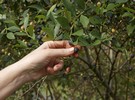Blueberry production has ramped up across Washington during the past 10 years, including in Eastern Washington, where blueberries traditionally weren’t grown until relatively recently.
Washington now ranks No. 1 in the country for overall blueberry production. In fact, Washington produces more organic blueberries than the rest of the states combined, according to Alan Schreiber, executive director of the Washington Blueberry Commission in Eltopia, north of Pasco.
“People historically liked blueberries because they tasted so good,” Schreiber said. “But there were some studies done, and we saw growth across the board. The health effects of blueberries really stimulated consumption and so the demand went up, the price went up and growers started planting.”
Gleaning the crop
Blueberries from Willow Wind get shipped throughout the country. Walser is one of the local leaders in Eastern Washington’s burgeoning organic blueberry industry, which is — along with conventional, or nonorganic, blueberries — in the midst of a dramatic period of growth and change.
Last year, Washington’s total harvest came in at 120 million pounds, or six times what it was 10 years ago, Schreiber said. It’s projected to weigh in at about 132 million pounds this year. And next year — assuming normal pollination and no drought — Schreiber projects the state’s blueberry harvest could reach 145 million pounds.
In all, there are about 18,000 acres of blueberries in Washington. Of that, about 5,000 acres are in Eastern Washington, which now produces about 40 percent of this state’s blueberry crop. “Eastern Washington has some of the largest blueberry growers in the world — all the way down to people who farm just a few rows of blueberries,” Schreiber said.
Whatcom County on the West Side still produces more than any other county in the state, with at least 7,000 acres of blueberries — a record number — twice as much as it grew in 2010. A third of those plants are 4 years old or younger.
Statewide, there’s significant new production from young fields. And Washington will continue to experience that growth. Last year, at least 1,000 new acres of blueberries were planted in this state.
Four ‘vibrant’ sectors
Production in Washington is made up of four sectors: organic fresh, organic processed, conventional fresh and conventional processed. “All four of those are very vibrant industries in Washington,” Schreiber said.
That’s partially because the blueberry plants here are some of the highest-yielding in the world, Schreiber said, noting they provide some 20,000 to 25,000 pounds per acre at maturity, even the organic fields.
Washington’s also particularly well-suited for blueberry production because it enjoys a wide temporal range for harvest. “We have the climate,” Schreiber said. “We also have a five-month picking window. No other state has that. Eastern Washington is early. Northwest Washington is late. We start picking the first week of June and we go until the middle of October.”
In Eastern Washington,”We don’t have the pest pressure that they have in a lot of places,” he said. “It’s easy to grow organic berries here. As a result, we grow as many organic blueberries here in Washington than the rest of the country combined.”
Last year, however, the industry didn’t have the capacity to fresh-pack or process the entire crop it produced. In fact, Schreiber estimates that at least 40 percent of Washington’s blueberry crop is packed or processed out of state. Oregon and British Columbia are primary destinations. But more than 2 million pounds each also go to Idaho and California, Schreiber said.
Washington’s blueberry industry “is leaving a lot of income on the table” by sending fruit out of state for packing and processing, he said.
Whatcom, Snohomish and Skagit counties on the West Side, and Benton and Franklin counties in Eastern Washington, and are the state’s top blueberry-growing areas. In northwest Washington, Schreiber said, there’s a need for increased fresh-pack capacity. And in Eastern Washington, he said, there’s a need for increased freezing capacity. “My No. 1 concern is: How do we manage an industry that is rapidly moving to producing 200 million pounds of fruit?”
Exports, competition
Schreiber wants to expand Washington’s blueberry exports — particularly to the Pacific Rim, including South Korea, India and Australia. Few blueberry growing regions are better situated for exports to that part of the world than Washington is, he said.
Imports are a growing concern, particularly from Peru, which can produce blueberries year-round and where production costs less.
Then, there are pests, such as spotted wing drosophila — small flies with red eyes that lay eggs in berries and stone fruit. Because of bugs and disease, it’s difficult to grow organic berries in Western Washington.
Eastern Washington, on the other hand, is almost an ideal place to grow blueberries, including organic blueberries. It is, for the most part, disease-free and pest-free.
“Here in Eastern Washington, we don’t have that many challenges,” Schreiber said. “Our issues would be getting enough people to pick blueberries and the high cost of labor.”
Another challenge is the soil itself. Blueberries, “are picky about that pH. They like low pH, really acidic soil. We start a year in advance prepping the fields,” Walser said, noting two years would be even better. “We have to really build the soil.”
The process involves adding compost, manure, sawdust, sulfur and rock phosphate to the soil well before planting. But that investment pays off. Blueberry plants, Walser said, “don’t really decline as long as you treat them well — and they don’t get some disease.”
So far, disease hasn’t been a major concern for blueberry growers on the East Side of the state. And Walser gives great care to his crop. He checks on them daily during blueberry season.
Source: chronline.com









